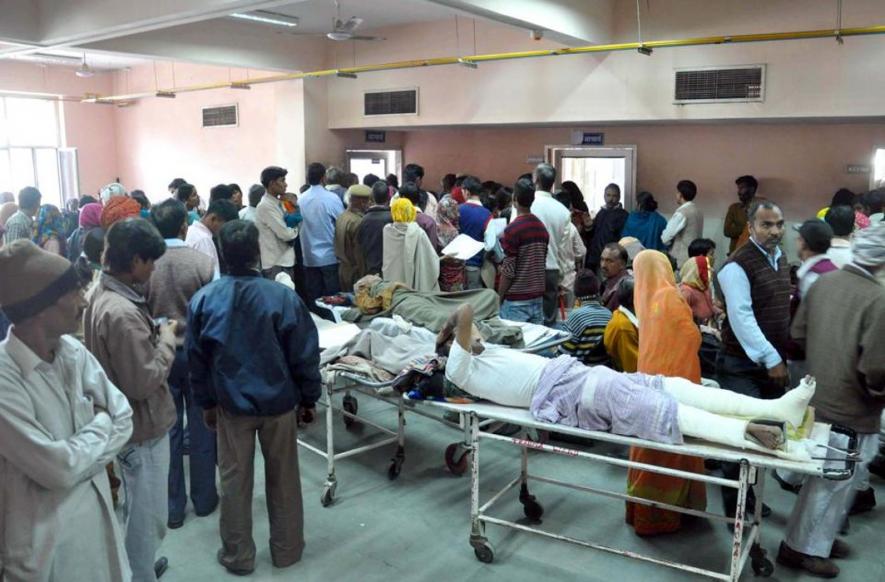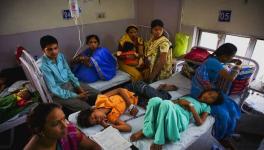CGHS Struggles With Poor Infrastructure and Shortage of Doctors

Image Courtesy: India Legal
The central government employees, pensioners, and their dependants across the country depend on the Central Government Health Scheme (CGHS) for comprehensive medical care. It is one of the biggest perks that comes with their job, and is often the only way central government employees posted in remote areas can access quality healthcare. However, the scheme that has beneficiaries in 52 cities across that country, seems to be ailing.
While the beneficiaries in bigger cities, like Delhi, are usually happy with the services they can access through the scheme, the picture is quite different in most of the smaller cities. The beneficiaries complain about insufficient number of dispensaries, about not having enough CGHS empanelled hospitals and discrepancies in pricing. And these are not the only problems faced by the beneficiaries.
Talking to NewsClick, a CGHS beneficiary from Siliguri said, “We have no empanelled hospitals or diagnostic centre here. There is just one CGHS dispensary in Siliguri, and one in Jalpaiguri. For quality medical care, we have to go to Kolkata, which has 12 CGHS empanelled private hospitals. These private hospitals also sometimes refuse to give us the benefits we are entitled to, because there are delays in payment of the dues to these hospitals by the government.”
He added, “We could go to the government hospitals, but everyone knows the condition of the government hospitals in West Bengal. Most hospitals lack modern infrastructure, they are overcrowded, and meeting a senior doctor is almost impossible. The junior residents who see that patients are already overburdened.”
Also Read: Are Mushrooming Private Colleges Creating a Surplus of Dentists?
The CGHS was initiated in 1954, and for more than six decades, it has been catering to the healthcare needs of eligible beneficiaries from all four pillars of democratic setup in India, namely legislature, judiciary, executive, and press. According to the Ministry of Health and Family Welfare (MoHFW), number of CGHS beneficiaries was 33,99,206 as on March 31, 2019.
Absence of proper infrastructure
According to the Ministry, the current number of functioning CGHS dispensaries, or wellness centres as they are called, are 373, out of which 288 are allopathic, 33 are ayurvedic, 35 are homeopathic, and the rest are unani, siddha, and yoga clinics. These 373 clinics are meant to serve as the first referral points for 33 lakh CGHS beneficiaries.
Currently, according to MoHFW, there are 24 CGHs cities across the country, spread over 17 states and two union territories. As per the data presented by the Minister of State for Health and Family Welfare Ashwini Kumar Choubey in the Parliament, a city has to have at least 6,000 serving employees of the central government and central civil pensioners for CGHS to be extended there. As a result, for the central government employees and pensioners living in areas with lesser number of beneficiaries have to sometimes travel large distances to access the benefits that they are entitled to.
Also Read: Overburdened Docs, Ill-equipped Hospitals: Chronic Disorder Continues to Grip Public Health
The cities that have CGHS beneficiaries, but are not considered CGHS cities by the central government – like Guntur, Vijayawada, Raipur, Siliguri – not only do not have enough dispensaries, but also do not have any empanelled hospitals or diagnostic centres. In an attempt to make the situation better, the government has merged postal dispensaries with CGHS dispensaries in some of these areas, but that barely solves the problem as these dispensaries continue to be understaffed.
When asked about whether the government has any proposal to amend the criteria to set up new dispensaries and to extend CGHS to new cities, Choubey replied in negative.
Shortage of doctors
While answering a question about the shortage of doctors in CGHS dispensaries, Choubey said in a written answer on June 21, 2019, “Yes, there is a shortage of Central Health Services (CHS) doctors in CGHS dispensaries. For due patient care, retired doctors are engaged on contract basis against vacant posts of regular doctors as an interim measure. Presently, a total of 204 doctors have been engaged on contract basis in various CGHS dispensaries all over India.”
As per data presented by Choubey in the Parliament on July 20, 2018, the total number of doctors working in CGHS dispensaries as of June 30, 2018 was just 1,612. During the same reference period, the number of beneficiaries was 31,49,161 according to MoHFW. One can infer from that that one doctor was available for every 1,953 beneficiaries.
However, this number does not give a clear picture of the situation. While there are enough number of doctors available in some cities, the doctor to population ratio is skewed in most of the CGHS cities. In Delhi, there are 853 doctors available for 16,65,908 beneficiaries, that is, one doctor is available for every 1,953 beneficiaries, which is the same as the average across the country.
Talking to NewsClick, a CGHS beneficiary from Delhi said, “It is not difficult for us to access the benefits. There’s a dispensary at 300 metres from my home, and even though we sometimes have to wait in the queue for a while, the services are worth it. There are six doctors in the dispensary.”
Also Read: Grim Picture of NRHM: Ailing CHCs and Shortage of Doctors
However, for a city like Shillong, the situation is much worse. In Shillong, the number of CGHS doctors is only four, but the number of beneficiaries is 19,760. Which is to say that there is one doctor available for every 4,940 beneficiaries. Shillong also has only two CGHS empanelled hospitals, and one empanelled diagnostic centre.
Talking about challenges in reforming CGHS, a recent paper said, “A systemwide reform in an established scheme requires careful generation of evidence, planning, stakeholders’ engagement and phased implementation. A patient explanation of the need for and elements of reform proposed is likely to convince key stakeholders, namely the leadership of the MoHFW, subscribers and participating hospitals of its inevitability and the immense opportunities that success offers.”
Get the latest reports & analysis with people's perspective on Protests, movements & deep analytical videos, discussions of the current affairs in your Telegram app. Subscribe to NewsClick's Telegram channel & get Real-Time updates on stories, as they get published on our website.
























